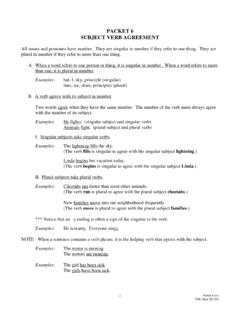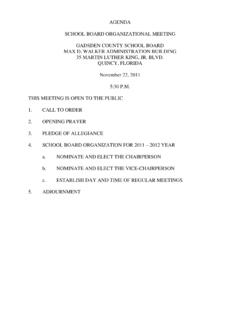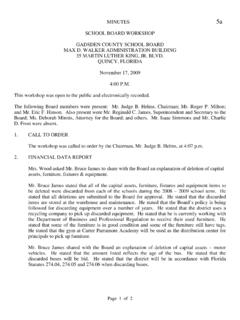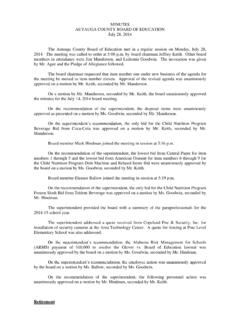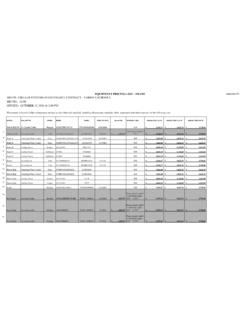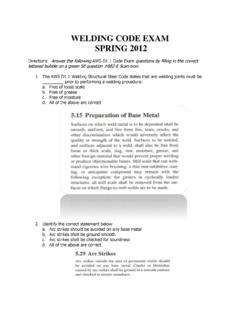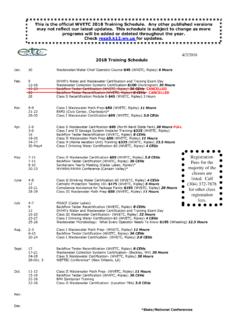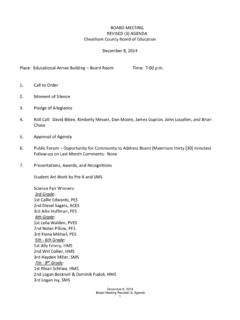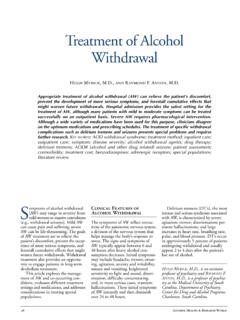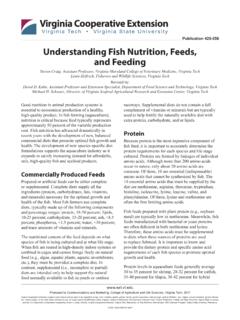Transcription of Chapter 16 The Citric Acid Cycle - PC\|MAC
1 Chapter 16 The Citric Acid CycleMultiple Choice Questions1. Production of acetyl-CoA (activated acetate)Page: 603 Difficulty: 2 Ans: AWhich of the following is not true of the reaction catalyzed by the pyruvate dehydrogenase complex? A) Biotin participates in the decarboxylation. B) Both NAD+ and a flavin nucleotide act as electron carriers. C) The reaction occurs in the mitochondrial matrix. D) The substrate is held by the lipoyl-lysine swinging arm. E) Two different cofactors containing SH groups participate. 2. Production of acetyl-CoA (activated acetate)Page: 603 Difficulty: 2 Ans: AWhich of the below is not required for the oxidative decarboxylation of pyruvate to form acetyl-CoA? A) ATP B) CoA-SH C) FAD D) Lipoic acid E) NAD+ 3. Production of acetyl-CoA (activated acetate)Page: 603 Difficulty: 2 Ans: EWhich combination of cofactors is involved in the conversion of pyruvate to acetyl-CoA?
2 A) Biotin, FAD, and TPP B) Biotin, NAD+, and FAD C) NAD+, biotin, and TPP D) Pyridoxal phosphate, FAD, and lipoic acid E) TPP, lipoic acid, and NAD+ 4. Production of acetyl-CoA (activated acetate)Page: 603 Difficulty: 2 Ans: AWhich of the following statements about the oxidative decarboxylation of pyruvate in aerobicconditions in animal cells is correct? A) One of the products of the reactions of the pyruvate dehydrogenase complex is a thioester ofacetate. B) The methyl ( CH3) group is eliminated as CO2. C) The process occurs in the cytosolic compartment of the cell. D) The pyruvate dehydrogenase complex uses all of the following as cofactors: NAD+, lipoic acid,pyridoxal phosphate (PLP), and FAD. E) The reaction is so important to energy production that pyruvate dehydrogenase operates at fullspeed under all conditions. Chapter 16 The Citric Acid Cycle1865.
3 Production of acetyl-CoA (activated acetate)Page: 605 Difficulty: 3 Ans: DGlucose labeled with 14C in C-3 and C-4 is completely converted to acetyl-CoA via glycolysis and thepyruvate dehydrogenase complex. What percentage of the acetyl-CoA molecules formed will belabeled with 14C, and in which position of the acetyl moiety will the 14C label be found? A) 100% of the acetyl-CoA will be labeled at C-1 (carboxyl). B) 100% of the acetyl-CoA will be labeled at C-2. C) 50% of the acetyl-CoA will be labeled, all at C-2 (methyl). D) No label will be found in the acetyl-CoA molecules. E) Not enough information is given to answer this question. 6. Reactions of the Citric acid cyclePage: 606 Difficulty: 3 Ans: AWhich of the following is not true of the Citric acid Cycle ? A) All enzymes of the Cycle are located in the cytoplasm, except succinate dehydrogenase, which isbound to the inner mitochondrial membrane.
4 B) In the presence of malonate, one would expect succinate to accumulate. C) Oxaloacetate is used as a substrate but is not consumed in the Cycle . D) Succinate dehydrogenase channels electrons directly into the electron transfer chain. E) The condensing enzyme is subject to allosteric regulation by ATP and NADH. 7. Reactions of the Citric acid cyclePage: 607 Difficulty: 3 Ans: AAcetyl-CoA labeled with 14C in both of its acetate carbon atoms is incubated with unlabeledoxaloacetate and a crude tissue preparation capable of carrying out the reactions of the Citric acidcycle. After one turn of the Cycle , oxaloacetate would have 14C in: A) all four carbon atoms. B) no pattern that is predictable from the information provided. C) none of its carbon atoms. D) the keto carbon and one of the carboxyl carbons. E) the two carboxyl carbons. 8. Reactions of the Citric acid cyclePage: 607 Difficulty: 1 Ans: BMalonate is a competitive inhibitor of succinate dehydrogenase.
5 If malonate is added to amitochondrial preparation that is oxidizing pyruvate as a substrate, which of the followingcompounds would you expect to decrease in concentration? A) Citrate B) Fumarate C) Isocitrate D) Pyruvate E) Succinate Chapter 16 The Citric Acid Cycle1879. Reactions of the Citric acid cyclePage: 607 Difficulty: 1 Ans: AWhich of the following is not an intermediate of the Citric acid Cycle ? A) Acetyl-coA B) Citrate C) Oxaloacetate D) Succinyl-coA E) -Ketoglutarate 10. Reactions of the Citric acid cyclePage: 607 Difficulty: 2 Ans: DIn mammals, each of the following occurs during the Citric acid Cycle except: A) formation of -ketoglutarate. B) generation of NADH and FADH2. C) metabolism of acetate to carbon dioxide and water. D) net synthesis of oxaloacetate from acetyl-CoA. E) oxidation of acetyl-CoA. 11. Reactions of the Citric acid cyclePage: 607 Difficulty: 3 Ans: BOxaloacetate uniformly labeled with 14C ( , with equal amounts of 14C in each of its carbon atoms)is condensed with unlabeled acetyl-CoA.
6 After a single pass through the Citric acid Cycle back tooxaloacetate, what fraction of the original radioactivity will be found in the oxaloacetate? A) all B) 1/2 C) 1/3 D) 1/4 E) 3/412. Reactions of the Citric acid cyclePage: 607 Difficulty: 1 Ans: BConversion of 1 mol of acetyl-CoA to 2 mol of CO2 and CoA via the Citric acid Cycle results in thenet production of: A) 1 mol of citrate. B) 1 mol of FADH2. C) 1 mol of NADH. D) 1 mol of oxaloacetate. E) 7 mol of ATP. Chapter 16 The Citric Acid Cycle18813. Reactions of the Citric acid cyclePage: 607 Difficulty: 2 Ans: EWhich one of the following is not associated with the oxidation of substrates by the Citric acid Cycle ? A) All of the below are involved. B) CO2 production C) Flavin reduction D) Lipoic acid present in some of the enzyme systems E) Pyridine nucleotide oxidation 14. Reactions of the Citric acid cyclePage: 607 Difficulty: 3 Ans: EThe two moles of CO2 produced in the first turn of the Citric acid Cycle have their origin in the: A) carboxyl and methylene carbons of oxaloacetateB) carboxyl group of acetate and a carboxyl group of oxaloacetate.
7 C) carboxyl group of acetate and the keto group of oxaloacetate. D) two carbon atoms of acetate. E) two carboxyl groups derived from oxaloacetate. 15. Reactions of the Citric acid cyclePage: 610 Difficulty: 2 Ans: AThe oxidative decarboxylation of -ketoglutarate proceeds by means of multistep reactions in whichall but one of the following cofactors are required. Which one is not required? A) ATP B) Coenzyme A C) Lipoic acid D) NAD+ E) thiamine pyrophosphate 16. Reactions of the Citric acid cyclePage: 610 Difficulty: 2 Ans: EThe reaction of the Citric acid Cycle that is most similar to the pyruvate dehydrogenase complex-catalyzed conversion of pyruvate to acetyl-CoA is the conversion of:A) citrate to ) fumarate to ) malate to oxaloacetate. D) succinyl-CoA to ) -ketoglutarate to 16 The Citric Acid Cycle18917. Reactions of the Citric acid cyclePage: 610 Difficulty: 2 Ans: EWhich one of the following enzymatic activities would be decreased by thiamine deficiency?
8 A) Fumarase B) Isocitrate dehydrogenase C) Malate dehydrogenase D) Succinate dehydrogenase E) -Ketoglutarate dehydrogenase complex 18. Reactions of the Citric acid cyclePage: 611 Difficulty: 1 Ans: EThe reaction of the Citric acid Cycle that produces an ATP equivalent (in the form of GTP) bysubstrate level phosphorylation is the conversion of:A) citrate to ) fumarate to ) malate to ) succinate to ) succinyl-CoA to Reactions of the Citric acid cyclePage: 612 Difficulty: 3 Ans: BThe standard reduction potentials (E' ) for the following half reactions are + 2H+ + 2e succinateE' = + VFAD + 2H+ + 2e FADH2E' = VIf succinate, fumarate, FAD, and FADH2, all at l M concentrations, were mixed together in thepresence of succinate dehydrogenase, which of the following would happen initially? A) Fumarate and succinate would become oxidized; FAD and FADH2 would become reduced.
9 B) Fumarate would become reduced; FADH2 would become oxidized. C) No reaction would occur because all reactants and products are already at their standardconcentrations. D) Succinate would become oxidized; FAD would become reduced. E) Succinate would become oxidized; FADH2 would be unchanged because it is a cofactor, not asubstrate. Chapter 16 The Citric Acid Cycle19020. Reactions of the Citric acid cyclePage: 612 Difficulty: 3 Ans: DFor the following reaction, G' = + NAD+ oxaloacetate + NADH + H+The reaction as written: A) can never occur in a cell. B) can only occur in a cell if it is coupled to another reaction for which G' is positive. C) can only occur in a cell in which NADH is converted to NAD+ by electron transport. D) may occur in cells at certain concentrations of substrate and product. E) would always proceed at a very slow rate 21.
10 Reactions of the Citric acid cyclePage: 612 Difficulty: 1 Ans: DAll of the oxidative steps of the Citric acid Cycle are linked to the reduction of NAD+ except thereaction catalyzed by: A) isocitrate dehydrogenase. B) malate dehydrogenase. C) pyruvate dehydrogenaseD) succinate dehydrogenase. E) the -ketoglutarate dehydrogenase complex. 22. Reactions of the Citric acid cyclePage: 612 Difficulty: 1 Ans: CWhich of the following cofactors is required for the conversion of succinate to fumarate in the citricacid Cycle ? A) ATP B) Biotin C) FAD D) NAD+ E) NADP+ 23. Reactions of the Citric acid cyclePage: 612 Difficulty: 1 Ans: EIn the Citric acid Cycle , a flavin coenzyme is required for: A) condensation of acetyl-CoA and oxaloacetate. B) oxidation of fumarate. C) oxidation of isocitrate. D) oxidation of malate. E) oxidation of succinate. Chapter 16 The Citric Acid Cycle19124.
